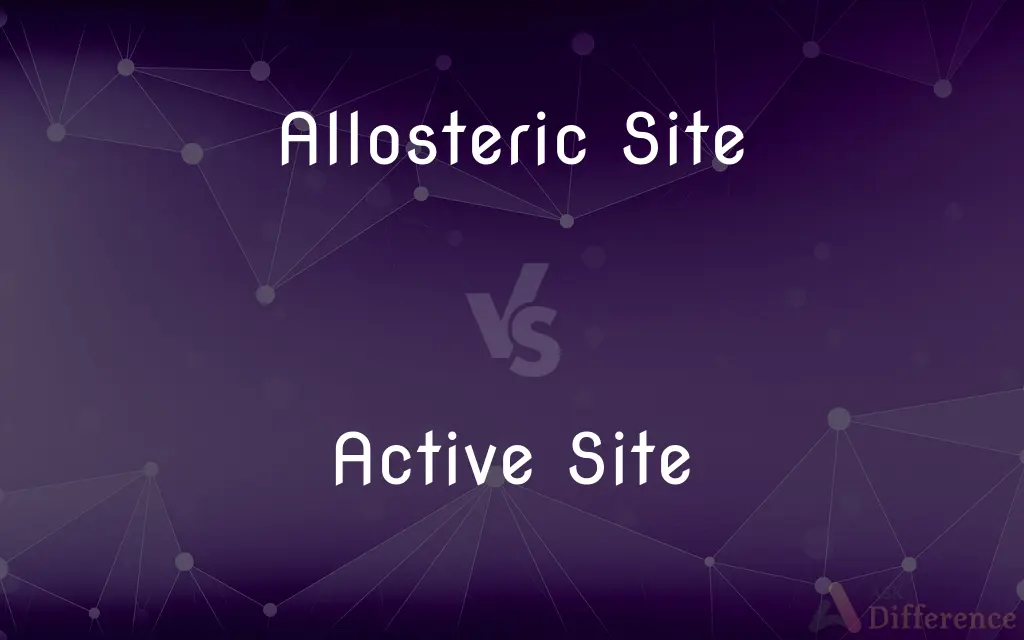Allosteric Site vs. Active Site — What's the Difference?
By Tayyaba Rehman — Published on November 16, 2023
The active site is where substrates bind and reactions occur in an enzyme, while the allosteric site is a separate site where molecules bind to regulate enzyme activity. The former directly facilitates reactions; the latter influences them indirectly.

Difference Between Allosteric Site and Active Site
Table of Contents
ADVERTISEMENT
Key Differences
Nature and Role: The active site of an enzyme is the region where the substrate molecules bind and undergo a chemical reaction. The allosteric site, in contrast, is a distinct location on the enzyme where regulatory molecules, called allosteric modulators, bind.
Functional Mechanism: While the active site is directly responsible for catalytic reactions, the allosteric site plays a regulatory role. When an allosteric modulator binds to the allosteric site, it can either activate or inhibit the enzyme's activity at the active site.
Binding Specificity: Substrates bind to the active site due to its complementary shape and chemistry, ensuring specificity. On the other hand, the allosteric site binds modulators that may not resemble the substrate, but their binding can alter the enzyme's conformation.
Regulation and Feedback: The active site doesn't usually change its function unless acted upon by external factors. However, the allosteric site allows for feedback mechanisms, where end products can inhibit or enhance enzyme activity, ensuring metabolic control.
Impact on Enzyme Shape: Binding at the active site typically doesn't change the enzyme's overall shape. In contrast, binding at the allosteric site often induces conformational changes, affecting the enzyme's overall activity.
ADVERTISEMENT
Comparison Chart
Nature and Role
Regulatory site of the enzyme
Reaction site of the enzyme
Functional Mechanism
Influences enzyme activity indirectly
Directly facilitates enzymatic reactions
Binding Specificity
Binds modulators distinct from substrates
Binds specific substrates due to complementary shape
Regulation
Allows for feedback mechanisms
Directly participates in catalysis
Impact on Shape
Induces conformational changes in the enzyme
Doesn't typically induce major conformational changes
Compare with Definitions
Allosteric Site
Where regulatory molecules bind to influence enzyme function.
An inhibitor at the allosteric site can deactivate the enzyme.
Active Site
The central hub of enzymatic catalysis.
The reaction was facilitated at the active site.
Allosteric Site
Can either enhance or inhibit enzymatic activity.
Activation at the allosteric site boosted the reaction rate.
Active Site
Dictates the enzyme's catalytic properties and reaction specificity.
The unique properties of the active site define the enzyme's function.
Allosteric Site
Involved in feedback regulation of enzyme activity.
End products binding to the allosteric site provide metabolic control.
Active Site
The region on an enzyme where substrates bind and reactions occur.
The substrate fits perfectly into the active site of the enzyme.
Allosteric Site
Induces conformational changes when bound with modulators.
Upon binding, the allosteric site changed the enzyme's shape.
Active Site
Ensures specificity due to its complementary shape to substrates.
Only the correct substrate can bind to the enzyme's active site.
Allosteric Site
A distinct location on an enzyme away from the active site.
The molecule bound to the allosteric site, altering enzyme activity.
Active Site
May be influenced by factors like pH and temperature.
The active site became deformed at high temperatures.
Common Curiosities
How do inhibitors affect the active site?
Inhibitors can block or change the active site, preventing substrate binding.
What primary function does an active site serve?
The active site is where substrates bind and enzymatic reactions occur.
Why is the active site's shape crucial?
The shape ensures specificity, allowing only the correct substrate to bind.
How does the allosteric site differ from the active site?
The allosteric site is a regulatory region, while the active site is where reactions take place.
Can a molecule bind simultaneously to both sites?
While uncommon, certain molecules can interact with both the active and allosteric sites.
Are all allosteric sites inhibitory?
No, allosteric sites can be either inhibitory or activating.
Does every enzyme have both an active and an allosteric site?
Not all enzymes have allosteric sites, but all have active sites.
Why are allosteric sites essential for metabolic pathways?
They allow for feedback regulation, maintaining metabolic balance.
How do allosteric inhibitors function?
They bind to the allosteric site, inducing a conformation that decreases enzyme activity.
Can environmental factors affect the active site?
Yes, factors like pH and temperature can impact the active site's shape and function.
Do allosteric sites exist on proteins other than enzymes?
Yes, some non-enzymatic proteins can have allosteric sites influencing their function.
How do allosteric activators work?
They bind to the allosteric site, promoting a conformation that enhances enzyme activity.
Can an enzyme have multiple active sites?
Yes, some multi-subunit enzymes can have several active sites.
Can mutations affect the active site?
Yes, mutations can alter the active site, potentially affecting enzyme function.
How do enzymes achieve specificity?
The unique shape and chemistry of the active site ensure specificity to certain substrates.
Share Your Discovery

Previous Comparison
Pine Wood vs. Teak Wood
Next Comparison
Radio Waves vs. Sound WavesAuthor Spotlight
Written by
Tayyaba RehmanTayyaba Rehman is a distinguished writer, currently serving as a primary contributor to askdifference.com. As a researcher in semantics and etymology, Tayyaba's passion for the complexity of languages and their distinctions has found a perfect home on the platform. Tayyaba delves into the intricacies of language, distinguishing between commonly confused words and phrases, thereby providing clarity for readers worldwide.













































